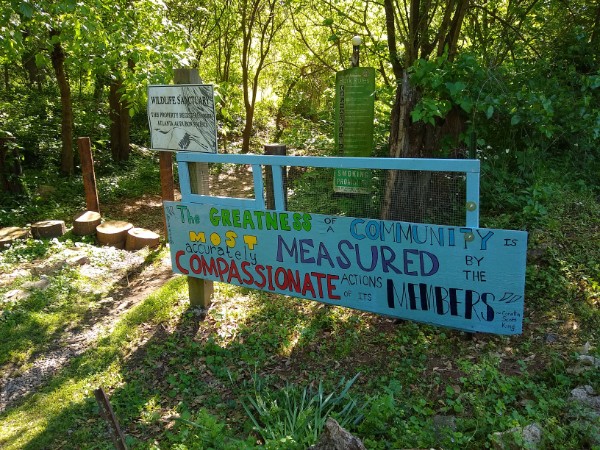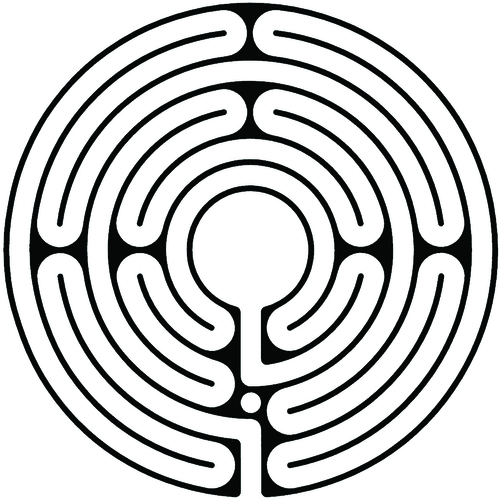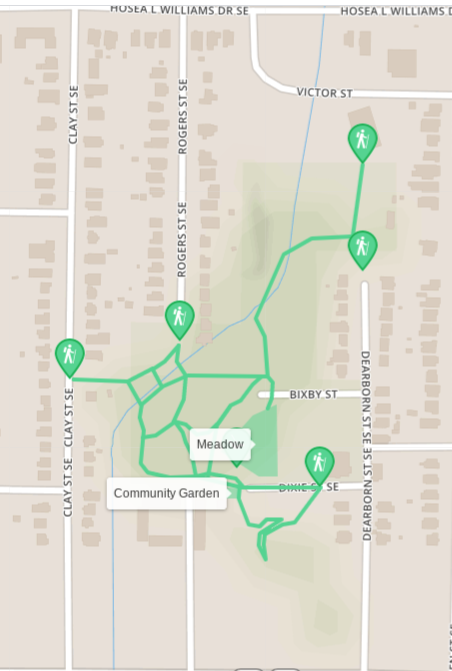Want to know how you can experience a labyrinth while walking in a maze? You may skip the prologue to go straight to the rules of the game, below.

Introduction to Walking Meditation
I love walking meditation. It’s actually easier than formal sitting meditation practice, but it can be just as beneficial. The idea is to keep your awareness on the path ahead of you, and your breath. When uninvited thoughts arise, gently release them and bring your awareness back to your steps. You might try counting how many steps occur during the in-breath and how many during the out. Find a thought process that helps you stay with the current moment. I just recommend staying with whatever internal technique you have decided on for the entire practice session.

Labyrinth is the ultimate walking meditation experience, for so many reasons which I won’t try to describe here. There is only one winding switch-back filled path from the entrance to the center, unlike in a maze. It’s a great way to let go of the mind’s habit of thinking about where we are going more than enjoying the journey.
The Backstory of this Idea
The Friday night before the spring equinox, I connected through zoom to a few of my friends from the Center for Transformational Practice (CTP) in White River Jct, VT to set intentions around a retreat that weekend. For years we have had quarterly retreats on the solstices and equinoxes, but of course this April that would not be possible while keeping appropriate social distance. To be honest I would not have traveled back to VT for the weekend from Atlanta, so this was yet another opportunity for me to practice virtually with distant friends.
Some of us decided to practice a 30/60 day on Saturday. This is a retreat format, where the participants alternate between meditating for 30 minutes and 60 minutes of work or any other activity you wish. We have done these in small groups at CTP before but sometimes it has been done by just Simon at CTP and one or more of us practicing the same at our own homes on the same day, so we had done this even before the COVID-19 era.
Elisabeth was not up for the 30/60 idea, but she said she would like to check in again at 3pm to do a labyrinth walk together, probably tracing paper ones together on a zoom call, I guess. Anyway, her voicing that idea gave me an idea which I’m excited to share with you today!
I’ve been doing walking meditation in the Kirkwood Urban Forest a lot more since the social distancing started. A practice that had been a once or twice a week has become daily, now that I’m working from home (on this website and on zoom group practices and classes) most of the time. When the time approached to check in to do labyrinth walking on-line, I was more in the mood to get outside for my regular walk, with a new enhancement!
The forest has a maze like set of paths. The map below is a pretty good representation, though not totally up-to-date. They meander all around the modest sized glade, up and down steps made from ragged slabs of recycled concrete, by a sandbox, around the community garden, by the peach trees and adjacent to a small creek that runs down one side. It’s really very beautiful, and now I’ve transformed it into a labyrinth!
I simply set some rules for myself as to how I’ll navigate, so that every turn through the maze is as prescribed as a labyrinth. The rules make the decision for me, I just mindfully follow them. You could come up with many rule sets that would serve, these are just my favorites to date.
Rules, in order of precedence
- At each intersection, take a (section of) path you have not yet walked this visit. When you get to an intersection where you have walked all the path choices, take the one you walked on first (earliest) this visit.
- When you get to an intersection where rule 1 is insufficient to discern your direction, turn onto the path furthest to the left, then alternate so at the next intersection, you take a hard right, back and forth, as long as the turn does not violate rule 1. If it would, keep going until you can turn the correct direction onto a path you have not yet walked. For example, at a simple 2-way fork where turning right is your next direction, that has already been traversed this visit but the left fork has not, you stay left and continue to look for a right turn you can take without violating rule 1.
To make your labyrinth longer without having to backtrack, do not take a path that you know will exit the forest or lead to a dead end.
To keep from even having to remember which direction I went last and therefore the direction I must turn, I pick up a small stick and hold it in the hand on the same side I must turn next. As soon as a legal turn in that direction is found I take it and switch the stick to the other hand. This may sound superfluous, but sometimes you will need to walk for a minute or more before you will come to any turns and if you are keeping your mind on your current foot falls and your breath, forgetting the last turn in some ways could be a good sign of current moment practice! Just as in a labyrinth, the stick relieves the mind of memory, everything is prescribed by rules and the token.
While I practice in my local forest, you may be familiar with a park or conservation area nearer you that has a maze of trails that would serve as a DIY labyrinth for your practice. If you can make it to Kirkwood, in Atlanta, GA this would be a fun way to give our little neighborhood gem a try, especially if you are devoted to walking meditation practice!
If you give this a try please let me know how it goes in the comments below, including what maze you transformed!

